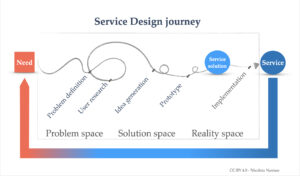Researchers often need support with many activities related to their scholarly endeavours. As Publishing Innovation Advisor for Scholarly Communication and Publishing at TU Delft’s Library Research Services, Nicoleta Nastase investigates the needs of researchers, mainly in publishing and citizen science, to improve existing services or to design new ones for and with researchers. Facilitating the journey from problem definition to meaningful solutions, her collaborative approach ensures that the tools, processes, and solutions developed at the Library will be used by the researchers who need them.
Design thinking

A little over three years ago Nastase joined the TU Delft Library as Publishing Innovation Advisor for Scholarly Communication and Publishing (formerly Research Support). She previously held an R&D position at the Library for five years and before that worked as information specialist for Applied Physics and Aerospace Engineering. As a facilitator for the research community at TU Delft, she says her role is mainly about services and processes. “I’m looking at the whole, I’m zooming out and zooming in on the processes, looking at the technology and what’s happening in scholarly communications,” she says. “The users, the researchers, are the focal point, so I try to understand their needs and bring improvements to their processes.”
To do this, Nastase uses a service design framework and design thinking methodologies to foster collaboration in the creation of services that have mutual benefits for everyone involved. That means not only making something for the users of the service, but also with them. “It’s important that you don’t do something just because you think it’s necessary,” she says. “Working together ensures that the researchers will embrace and use what you create because they already know they need it.”
Making things a reality

There are multiple steps in the process of making services or solutions a reality. Nastase’s work involves trends analysis, needs discovery, problem definition, and solutions generation, as well as prototyping for successful service implementation. She summarises these into three categories that she calls problem space, solution space, and reality space. She also facilitates ideation sessions, helping people think about different solutions and eventually choosing something to work with.
The problem-solving approach that Nastase employs can be used with many different types of processes. For example, she has been instrumental in bringing together a citizen science community at TU Delft, which involved bundling existing tools and services and building up an infrastructure for researchers working in citizen science at the university. Nastase has also been closely involved in the publishing process for quite some time, producing insights on the adoption of new technological developments in academic publishing.
A new way to publish
The whole scholarly communication landscape has been changing over the last years, notes Nastase. “You could see a lot of things changing in the peer review approach or in rewards and recognition, but also in the publishing processes themselves,” she says. There was a growing sentiment amongst researchers of being unhappy with how long it takes to publish and frustration that the publishing process is not transparent. Together with colleague Frédérique Belliard, Senior Publishing Officer at TU Delft OPEN Publishing, they started thinking about a solution.
The pair learned about a CERN startup called Orvium, an open access scientific publishing platform created by and for researchers. “We discovered we had a similar philosophy and they had developed a platform with the same goals as ours which could support our design and requirements,” says Nastase. They jointly established The Evolving Scholar, an open access, community-driven journal that supports open peer review and novel types of publications and puts the authors, the reviewers, and the moderators in lead.
Giving researchers control
They did not have the ambition to be in competition with the big impact factor journals, says Nastase. Instead, the goal was to create a platform for researchers to control their own publishing process. “From the beginning, we wanted to offer a kind of experimental space, a playground for researchers unhappy with publishing processes or big publishing houses,” Nastase says. “We were looking at users that are the avant-garde of researchers who are at a certain stage in their career where they could say they want to publish differently.”
Nastase said they also wanted to create a community driven platform that offers the possibility of building multidisciplinary communities around subjects. For example, a community can be aggregated around a topic like citizen science where someone takes responsibility for moderation and ensures that it maintains and academic standard of discourse. And another sort of community has emerged, as TU Delft researchers organising conferences have become interested in The Evolving Scholar. Nastase said that the Bicycle and Motorcycle Dynamics (BMD) Conference 2023 is now the third conference to successfully use the platform to publish conference papers and later a book of proceedings with TU Delft OPEN Publishing.
Just as Nastase’s work in research support can be applied to a wide range of processes, there are a lot of ways that the Evolving Scholar can add value to the researchers who use it. “What I would like people to know is that they can use it as an experimental space,” she says. “They can get the control of their own community and they be in control of publishing their own work.”
